Old World warblers are a large group of birds formerly grouped together in the bird family Sylviidae. The family held over 400 species in over 70 genera, and were the source of much taxonomic confusion. Two families were split out initially, the cisticolas into Cisticolidae and the kinglets into Regulidae. In the past ten years they have been the subject of much research and many species are now placed into other families, including the Acrocephalidae, Cettiidae, Phylloscopidae, and Megaluridae. In addition some species have been moved into existing families or have not yet had their placement fully resolved. A smaller family of warblers, together with some babblers formerly placed in the family Timaliidae and the parrotbills, are retained in a much smaller family Sylviidae.
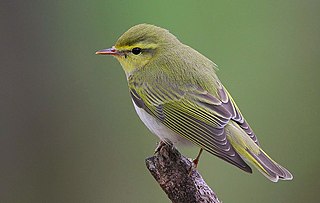
Various Passeriformes are commonly referred to as warblers. They are not necessarily closely related to one another, but share some characteristics, such as being fairly small, vocal, and insectivorous.

Tree warblers are medium-sized warblers in the marsh- and tree-warbler family Acrocephalidae. They are found in Europe, Africa and western Asia. Until recently, they were all classified in the single genus Hippolais.

The vireos make up a family, Vireonidae, of small to medium-sized passerine birds found in the New World and Southeast Asia. "Vireo" is a Latin word referring to a green migratory bird, perhaps the female golden oriole, possibly the European greenfinch.

The Acrocephalus warblers are small, insectivorous passerine birds belonging to the genus Acrocephalus. Formerly in the paraphyletic Old World warbler assemblage, they are now separated as the namesake of the marsh and tree warbler family Acrocephalidae. They are sometimes called marsh warblers or reed warblers, but this invites confusion with marsh warbler and reed warbler proper, especially in North America, where it is common to use lower case for bird species.

Hippolais is a genus of tree warbler in the family Acrocephalidae. It is sometimes associated with the genus Iduna. The genus name Hippolais is from Ancient Greek hupolais, as misspelt by Linnaeus. It referred to a small bird mentioned by Aristotle and others and may be onomatopoeic or derived from hupo,"under", and laas, "stone".

The thick-billed warbler breeds in the temperate east Palearctic. South Siberia to West Mongolia.It is migratory, wintering in tropical South Asia and South-east Asia. It is a very rare vagrant to western Europe.
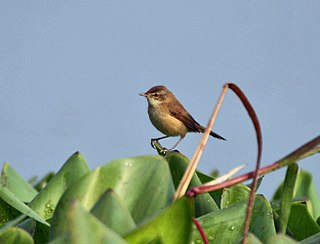
The paddyfield warbler is a species of marsh warbler. It was formerly included in the "Old World warbler" assemblage. The Manchurian reed warbler was included in A. agricola as a subspecies.

The western olivaceous warbler, also known as isabelline warbler, is a "warbler", formerly placed in the Old World warblers when these were a paraphyletic wastebin taxon. It is now considered a member of the acrocephaline warblers, Acrocephalidae, in the tree warbler genus Iduna. It was formerly regarded as part of a wider "olivaceous warbler" species, but as a result of modern taxonomic developments, this species is now usually considered distinct from the eastern olivaceous warbler, Iduna pallida.
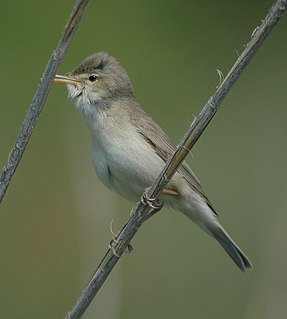
The eastern olivaceous warbler is a small passerine bird with drab plumage tones, that is native to the Old World. For the most part it breeds in the northern Afrotropics and winters in southeastern Europe, the Middle East and adjacent western Asia.

The booted warbler is an Old World warbler in the tree warbler group. It was formerly considered to be conspecific with Sykes's warbler, but the two are now usually both afforded species status. Booted warbler itself breeds from central Russia to western China, and migrates to winter in the Indian subcontinent as far south as Sri Lanka. Booted warbler has expanded its breeding range westward in recent decades and nests now as far west and north as Finland. It is a small passerine bird, found in open country with bushes and other tall vegetation. 3-4 eggs are laid in a nest in a bush or vegetation. Like most warblers they are insectivorous.

Sykes's warbler is an Old World warbler in the tree warbler family. It was formerly considered a subspecies of the booted warbler, but is now considered a full species. Its breeding range is from northeast Arabia to Turkestan, West China and Afghanistan. Like the booted warbler, many populations of the species migrate in winter to the Indian subcontinent as far south as Sri Lanka.

The Acrocephalidae are a family of oscine passerine birds, in the superfamily Sylvioidea.

The papyrus yellow warbler, papyrus flycatcher-warbler or thin-billed flycatcher-warbler, is a species of tree warbler; formerly, these were placed in the paraphyletic "Old World warblers". It is monotypic in its genus. It is found in Burundi, Democratic Republic of the Congo, Kenya, Rwanda, Tanzania, Uganda, and Zambia. Its natural habitat is swamps. It is threatened by habitat loss.
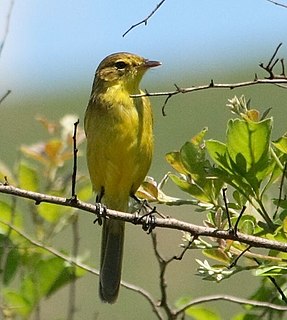
Chloropeta was a genus of Acrocephalidae warblers; formerly, they were placed in the paraphyletic "Old World warblers". Now the papyrus yellow warbler is placed in its monotypic genus Calamonastides, with the others placed in the genus Iduna.
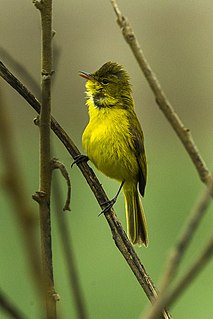
The African yellow warbler, Natal yellow warbler, dark-capped yellow warbler, or yellow flycatcher-warbler is a species of Acrocephalidae warblers; formerly, these were placed in the paraphyletic "Old World warblers".

The mountain yellow warbler or mountain flycatcher-warbler is a species of Acrocephalidae warbler; formerly, these were placed in the paraphyletic "Old World warblers".

Nesillas is a genus of Old World warbler in the family Acrocephalidae. Established by Harry Church Oberholser in 1899, it contains the following species:

The chestnut-headed tesia is a small insectivorous songbird formerly of the "Old World warbler" family but nowadays placed in the bush warbler family (Cettiidae).

The Nauru reed warbler, Acrocephalus rehsei, is a passerine bird endemic to the island of Nauru in the Pacific Ocean. It is one of only two native breeding land-birds on Nauru and it is the only passerine found on the island. It is related to other Micronesian reed warblers, all of which evolved from one of several radiations of the genus across the Pacific. Related warblers on nearby islands include the Carolinian reed warbler, with which the Nauru species was initially confused, and the nightingale reed warbler, which was formerly sometimes considered the same species.


















